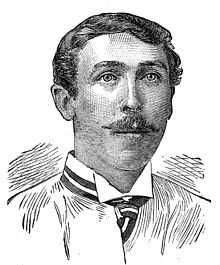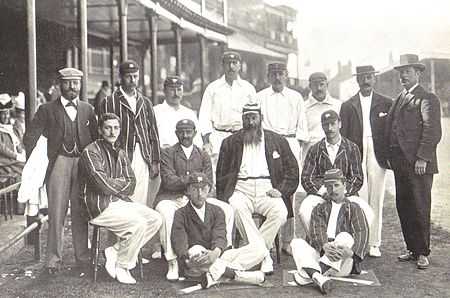William Gunn (cricketer)
 | ||||||||||||||||||||||||||||||||||||||||
| Cricket information | ||||||||||||||||||||||||||||||||||||||||
|---|---|---|---|---|---|---|---|---|---|---|---|---|---|---|---|---|---|---|---|---|---|---|---|---|---|---|---|---|---|---|---|---|---|---|---|---|---|---|---|---|
| Batting style | Right-handed batsman | |||||||||||||||||||||||||||||||||||||||
| Bowling style | Underarm Right-arm slow | |||||||||||||||||||||||||||||||||||||||
| International information | ||||||||||||||||||||||||||||||||||||||||
| National side |
| |||||||||||||||||||||||||||||||||||||||
| Career statistics | ||||||||||||||||||||||||||||||||||||||||
| ||||||||||||||||||||||||||||||||||||||||
| Source: | ||||||||||||||||||||||||||||||||||||||||
William "Billy" Gunn (4 December 1858 – 29 January 1921) was an English sportsman who played internationally in both cricket and football. In first-class cricket, Gunn played professionally for Nottinghamshire from 1880 to 1904 and represented England in 11 Test matches. In football, he played for both Notts County and Nottingham Forest as an amateur and played twice for England, scoring one goal in the inaugural 1884 British Home Championship.[1]
Cricket career

Born at St Anne's, Nottingham, Gunn was a specialist right-handed batsman (RHB) who occasionally bowled slow underarm lobs. He was an outfielder who was noted for his accurate throwing. His most successful season was 1889, following which he was voted Wisden Batsman of the Year. He joined his Nottinghamshire colleagues Alfred Shaw and Arthur Shrewsbury in the English cricket team in Australia in 1886–87.
In his Wisden citation, Gunn was described in the following terms:[2]
...we think we are correct in saying that no batsman of the same height has ever played in more elegant and perfect form. Even before he rose to his fame as a batsman, Gunn was one of the most brilliant fields in the country, and it was the general opinion of practical cricketers of his era that in the long field and at third man he had never had a superior. Gunn was a member of Alfred Shaw and Arthur Shrewsbury's team in Australia during the season of 1886/7, and averaged 21.8 in eleven-a-side matches, and 20.7 in all matches.
Football career

Gunn was approximately 6 ft 2 in tall and had the ability to throw a football long distances, "establishing himself as the Delap of his day by hurling the ball inhuman distances... with one hand".[1] At the time, rules for throw-ins were not formalised, but when his throws "repeatedly hurtled into Scotland's penalty area from well inside England's own half" in an unofficial match in 1882, he "forced the FA to change the law to [that of] ... today."[1]
Wisden described his footballing career in the following terms: "For several years Gunn was one of the most brilliant forwards in the country at Association football, but latterly gave up the game, reserving himself entirely for cricket."[2]
Business career
Gunn founded the sports equipment firm Gunn and Moore in 1885 and became the first former professional cricketer to serve on a county club committee. His nephews, George and John Gunn, were both England Test cricketers.
He died 29 January 1921 at Standard Hill, Nottingham.
References
External links
- CricketArchive page on Billy Gunn
- Cricinfo page on Billy Gunn
- Brief profile of William Gunn by Don Ambrose
- Wisden Online – 1890